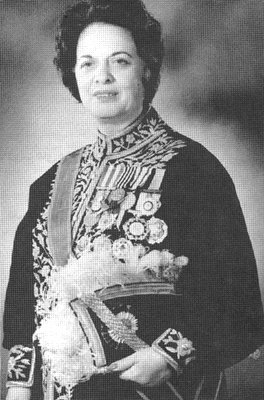- Farrokhroo Parsa
Infobox Politician
name = Farrokhroo Parsa
caption = Dr Farrokhroo Pārsā in ministerial regalia
office = Education minister of Iran
term_start =27 August 1968
term_end = 1971 [ [http://www.guide2womenleaders.com/Iran.htm Iran Ministers ] ]
deputy =
predecessor =Parviz Natel-Khanlari ?
successor =Manouchehr Ganji
birth_date =22 March 1922
birth_place =Qom
residence = Tehran, Iran
death_date =8 May 1980
death_place = Tehran
party =
religion = Disputed
spouse = Married
profession =Physician ,politician Farokhroo Pārsā, (1922-1980) (PerB|فرخرو پارسا) was an
Iran ian physician, educator and parliamentarian. She served as Minister of Education of Iran in the last pre-Islamic revolution government and was the first female cabinet minister of an Iranian government.Pārsā was an outspoken supporter of women's rights in Iran, and was executed by firing squad on 8 May 1980 on religious-revolutionary charges stemming from this position.
__TOC__
Biography
Farrokhroo Pārsā was born on
22 March 1922 in Qom, Iran to Farrokh-Din and Fakhr-e Āfāgh Pārsā. Her mother, Fakhr-e Āfāgh, was the editor of the women's magazine "Jahān-e Zan" ("The World of Woman"),citation|last=Bahrami|first=Ardavan|title=A woman for all seasons: In memory of Farrokhrou Parsa|year=2005|date=May 9, 2005|publisher=iranian.com|url=http://www.iranian.com/ArdavanBahrami/2005/May/Parsa/index.html.] and a vocal proponent forgender equality and for educational opportunities for women. Her views on this subject met with opposition of the conservative sections of the society of her time, leading to the expulsion of the family by the government of Ahmad Qavām, fromTehran toQom , where Fakhr-e Āfāgh was placed under house arrest. It was here that Farrokhroo was born, some minutes past midnight on Iranian New Year's Eve 1922 (Nowruz , 1301 AH).Upon obtaining a medical degree, Pārsā became a
biology teacher in Jeanne d'Arc Highschool in Tehran. At the school she came to knowFarah Diba , one of her students at this school, and who would later become wife of King Mohammad Reza Pahlavi. [citation|last=Pahlavi-Diba|first=Farah|title=In memory of Mrs. Farrokhrou Parsa executed on May 8, 1980|series=(in Persian)|date=May 8, 2000|year=2000|publisher=farahpahlavi.org|url=http://www.farahpahlavi.org/parsa.html.]In 1963, Pārsā was elected to parliament (the "Majles"), and began petitioning Mohammad Reza Pahlavi for
suffrage for Iran's women. She was also a driving force for legislation that amended the existing laws concerning women and family. In 1965 Pārsā was appointed Deputy Minister of Education and on 27 August 1968 she became Minister of Education in the cabinet of the Amir-Abbas Hoveyda government. It was the first time in the history of Iran that a woman has occupied a cabinet position.Farrokhroo Pārsā was executed by firing squad on 8 May 1980 in
Tehran , [citation|last=Lentz|first=Harris M.|chapter=Farrokhrou Parsa|title=Assassinations and Executions: An Encyclopedia of Political Violence, 1865-1986|location=Jefferson|publisher=McFarland|page=208.] at the outset of theIslamic Cultural Revolution , on charges of "spreading vice on Earth and fighting God".citation|last=Bahrami|first=Ardavan|title=A woman for all seasons: In memory of Farrokhrou Parsa|year=2005|date=May 9, 2005|publisher=iranian.com|url=http://www.iranian.com/ArdavanBahrami/2005/May/Parsa/index.html.]In her last letter from prison, Farrokhroo Pārsā wrote to her children: "I am a doctor, so I have no fear of death. Death is only a moment and no more. I am prepared to receive death with open arms rather than live in shame by being forced to be veiled. I am not going to bow to those who expect me to express regret for fifty years of my efforts for equality between men and women. I am not prepared to wear the
chador and step back in history."Her successor as the Education Minister of Iran,
Manouchehr Ganji , expressed surprise at her execution: she was "a lady, [...] Doctor , a competent physician who entertained good relations at the Ministry with revolutionaries likeBeheshti ,Bahonar , andRejaii ." [citation|last=Ganji|first=Manouchehr|authorlink=Manouchehr Ganji|title=Defying the Iranian Revolution: From a Minister to the Shah to a Leader|year=2002|page=80 [http://books.google.com/books?id=NboVl-CeYs0C&pg=PA80&dq=Farokhrou+Parsa&sig=trwcrAcPO8sYNARk4mSJak8m8pI] .]After her execution, government newspapers (including
Kayhan [Kayhan, 27 April, 1980] ,Ettela'at [Ettela'at, 23 April, 1980] ) claimed that Farrokhroo Pārsā was a member of theBahai community. Such a claim may be attributed to the general perception that advocates for women's rights are Bahais (seeIranian women's movement for details). In her personalblog Pārsā's niece Roya Parsay unequivocally states that her aunt "was NOT a Bahai." [citation|url=http://inconversationwithroya.blogspot.com/|title=A Bit of Iran's Legacy|first=Roya|last=Parsay|date=March 14, 2005|year=2005.]References
External links
* A photograph of [http://www.iranian.com/ArdavanBahrami/2005/May/Parsa/Images/p2.jpgFarrokhroo Pārsā in conversation with Amir-Abbās Hoveydā] .
* An old photograph of the [http://www.flickr.com/photos/37764682@N00/6123674/ young family of Farrokh-Din Pārsā and Fakhr-e Āfāgh Pārsā] .
Wikimedia Foundation. 2010.
